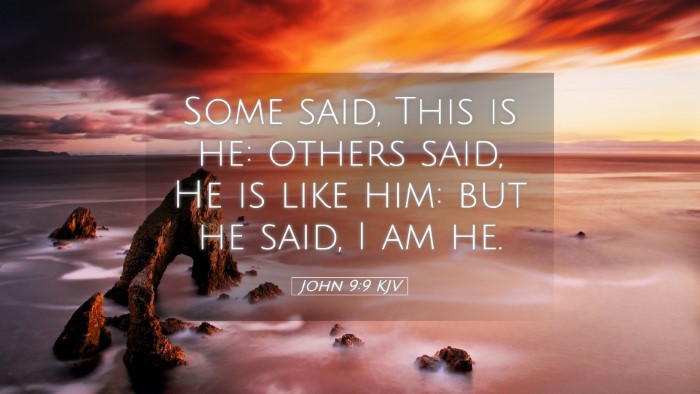Commentary on John 9:9
Verse Context: John 9:9 reads: "Some said, This is he: others said, He is like him: but he said, I am he." This verse is a part of the narrative surrounding the healing of the blind man, which reveals not only the miraculous work of Christ but also deep theological and social implications.
Introduction
The healing of the man born blind in John 9 is a profound story that symbolizes spiritual enlightenment and the transformative power of Christ. This verse, John 9:9, captures a moment of identity recognition, confusion, and the varying responses to miraculous events.
Interpretive Insights
-
Understanding Identity and Recognition
In this verse, the man previously blind asserts his identity. Both the crowds and the healed man grapple with recognizing who he is now that he has received sight. Matthew Henry notes that this interaction serves not only as a physical recognition but as a metaphor for spiritual awakening. The crowd's mixed responses underscore the confusion surrounding Christ's miracles and their implications.
-
Public Perception of Miracles
Albert Barnes comments on the nature of the crowd's reaction, emphasizing that human beings often struggle to understand profound changes when they encounter them. The division among the observers reveals the tension between belief and skepticism. Many people want to categorize the miracle, either attributing it to Jesus or misunderstanding it as coincidence or similarity without grasping the full impact of the event.
-
The Testimony of the Healed Man
Adam Clarke brings forth the idea that the man’s insistence, "I am he," showcases a confidence born from a personal experience with Christ. This moment highlights the importance of personal testimony in the life of a believer. The man, who was once blind, not only confirms his identity but also his transformation, reflecting the necessity of acknowledging one's own encounter with the divine.
Theological Implications
John 9:9 invites readers to delve deeper into several theological themes:
-
The Nature of Faith
The varying reactions of individuals depict different levels of faith and understanding. Some see the man as just another person transformed, while others realize the miracle attributed to Jesus. This mirrors the broader biblical narrative where faith is a prerequisite for understanding and seeing the truth.
-
Discipleship and Witness
The healed man stands as a model of discipleship, as his acknowledgment of his condition and the miraculous change reflects the journey of many believers. He embodies the call to witness; despite societal disbelief and skepticism, he openly identifies with Christ's work in his life, challenging the onlookers to reconsider their assumptions.
-
Spiritual Blindness
This passage can be viewed as a larger commentary on spiritual blindness. The individuals who doubt and question the authenticity of the healing illustrate a state of spiritual blindness that persists even in the face of miracles. Biblical scholars like Clarke often emphasize the importance of spiritual perception, suggesting that true sight comes from acknowledging Jesus' divine authority.
Historical Context
Understanding the historical backdrop is essential to grasp the full significance of John 9:9. In the context of first-century Judaism, miracles were a significant aspect of religious life. The response of the people reflects their cultural and religious expectations. The Jewish authorities often viewed miraculous claims with suspicion, thus highlighting the tension between Jesus' ministry and the established religious order.
Personal Application
The challenge presented in John 9:9 extends to modern-day believers. It calls for self-examination regarding how one perceives the works of Christ in their life. Questions arise: Are we willing to acknowledge our transformations in faith? Do we express our experiences to others with confidence? Reflecting on this verse encourages believers to boldly declare their identity in Christ, irrespective of societal opinions.
Conclusion
In conclusion, John 9:9 serves as a rich tapestry woven with themes of identity, recognition, faith, and testimony. Both the responses of the crowd and the declaration of the healed blind man invite believers and scholars alike to ponder their own journeys of faith. As pastors and theologians explore this passage, they are reminded of the importance of proclaiming one's experiences of Christ's transformative work and witnessing to the truth, much like the man born blind did.


